Get rid of redirects to and from bigclicker.me
Notification SpamAlso Known As: bigclicker.me pop-up
Get free scan and check if your device is infected.
Remove it nowTo use full-featured product, you have to purchase a license for Combo Cleaner. Seven days free trial available. Combo Cleaner is owned and operated by RCS LT, the parent company of PCRisk.com.
What is bigclicker[.]me?
Bigclicker[.]me is a rogue site, akin to naneso.com, pushmehoney.com, ernorvious.com and many others. It is designed to cause unauthorized redirects to unreliable/malicious websites and to present visitors with highly dubious content (including click-bait). There are thousands of rogue sites out there and it is rare for visitors to access them willingly.
Most get redirected by clicking on intrusive advertisements (commonly hosted by compromised websites) or by PUAs (potentially unwanted applications) force-opening them. It should be mentioned that these applications do not require express user permission (in some instances, even knowledge) to be installed onto their devices.
PUAs generate rampant redirects to untrustworthy/malignant sites, deliver intrusive advertisement campaigns (pop-ups, banners, coupons, etc.) and gather vulnerable data.
![bigclicker[.]me pop-up redirects](/images/stories/screenshots201906/bigclickerme-homepage.jpg)
There are two main ways that rogue websites spread: trough intrusive ads and PUAs. When clicked, invasive adverts promote bigclicker[.]me by redirecting unsuspecting users to it. Unwanted applications forcefully open new browser tabs/windows and likewise redirect users to this site.
The course of action that bigclicker[.]me follows, begins with checking visitors' IP (Internet Protocol) address, in order to find out their geolocations. Once this information is learnt, bigclicker[.]me either redirects users elsewhere and/or starts feeding them dubious content.
Regardless of its exact actions, what must be understood is that visitors to this site are bound to encounter malignant content. Additionally, bigclicker[.]me uses click-bait (e.g. "press allow to verify that you are not a robot", "click here to verify that you are human", "your page is loading, click here to continue" and so on) to trick users into consenting to its browser notifications.
Once allowed, bigclicker[.]me begins running intrusive ad campaigns. These advertisements cause redirects to unreliable/malicious websites and some can even execute scripts, designed to autonomously download/install PUAs. As stated previously, these applications can also redirect users to hazardous sites and deliver invasive adverts.
The type of ads that PUAs deliver can seriously affect browsing quality; limit site visibility (by covering content) and browsing speed. Another ability that PUAs have is data tracking. By gathering intel on users' browser activity, they can infer their personal information.
What is crucial to understand, is that the gathered data is then passed onto third parties (possibly, cyber criminals), seeking to misemploy it for profit. In other words, presence of PUAs in one's device can endanger the integrity of their browser and system, as well as lead to serious privacy issues (even identity theft). Therefore, all rogue applications should be removed without delay.
| Name | bigclicker.me pop-up |
| Threat Type | Push notifications ads, Unwanted ads, Pop-up ads |
| Serving IP Address | 167.71.12.147 |
| Observed Domains | 0.bigclicker[.]me, 1.bigclicker[.]me, 10.bigclicker[.]me, 2.bigclicker[.]me, 3.bigclicker[.]me, 5.bigclicker[.]me, 9.bigclicker[.]me |
| Symptoms | Seeing advertisements not originating from the sites you are browsing. Intrusive pop-up ads. Decreased Internet browsing speed. |
| Distribution Methods | Deceptive pop-up ads, potentially unwanted applications (adware) |
| Damage | Decreased computer performance, browser tracking - privacy issues, possible additional malware infections. |
| Malware Removal (Windows) |
To eliminate possible malware infections, scan your computer with legitimate antivirus software. Our security researchers recommend using Combo Cleaner. Download Combo CleanerTo use full-featured product, you have to purchase a license for Combo Cleaner. 7 days free trial available. Combo Cleaner is owned and operated by RCS LT, the parent company of PCRisk.com. |
Potentially unwanted applications are vast in their numbers, though many share distinct similarities. Most are successfully designed to appear legitimate and harmless. To lure more users into installing them, they also tend to offer a wide variety of "useful" and "beneficial" features.
However, they rarely work as advertised and frequently are nonfunctional. These apps are designed for the sole purpose of creating profit for their developers; to users - they are of no value whatsoever. Instead, they cause redirects, deliver intrusive advertisements and track data.
How did adware install on my computer?
PUAs can infiltrate devices through rogue installs committed by invasive adverts. Another way that said apps spread are by being installed by users themselves, along with regular software. "Bundling" is a false marketing method, when ordinary programs are packed with undesirable applications.
This tactic has high success rates with hasty and inattentive users. While opt-outs from installing any additional apps/features are frequently possible, they are often hidden within the "Custom/Advanced" settings and other options. In summary, carelessness when browsing and rushing through installation procedures - endangers the safety of users and their devices.
How to avoid installation of potentially unwanted applications?
Only official and verified sources should be used for downloading software (with direct download links being top priority). Using P2P (peer-to-peer) sharing networks and other third party downloaders - is ill-advised, as programs there are more likely to be pre-packed with PUAs.
Installation recommendations include: reading terms, studying possible options, using "Custom/Advanced" settings, opting-out/declining any offers to download/install supplementary applications/features. Users should avoid suspicious websites and ads. It should be noted that intrusive advertisements tend to look absolutely innocuous, which can make them difficult to identify.
However, a telltale sign of invasive adverts can be the sites they redirect to, e.g. gambling, pornography, adult-dating and similar. To summarize, user attentiveness and caution towards downloading/installing software, as well as browsing - are crucial to ensuring their safety.
Should users encounter ads/redirects of this kind, they are strongly advised to inspect their system and remove any dubious apps and/or browser extensions/plug-ins. If your computer is already infected with rogue applications, we recommend running a scan with Combo Cleaner Antivirus for Windows to automatically eliminate them.
Appearance of bigclicker[.]me website (GIF):
![bigclicker[.]me website appearance (GIF)](/images/stories/screenshots201906/bigclickerme-appearance.gif)
Instant automatic malware removal:
Manual threat removal might be a lengthy and complicated process that requires advanced IT skills. Combo Cleaner is a professional automatic malware removal tool that is recommended to get rid of malware. Download it by clicking the button below:
DOWNLOAD Combo CleanerBy downloading any software listed on this website you agree to our Privacy Policy and Terms of Use. To use full-featured product, you have to purchase a license for Combo Cleaner. 7 days free trial available. Combo Cleaner is owned and operated by RCS LT, the parent company of PCRisk.com.
Quick menu:
- What is bigclicker.me pop-up?
- STEP 1. Remove spam notifications from Google Chrome
- STEP 2. Remove spam notifications from Google Chrome (Android)
- STEP 3. Remove spam notifications from Mozilla Firefox
- STEP 4. Remove spam notifications from Microsoft Edge
- STEP 5. Remove spam notifications from Safari (macOS)
Disable unwanted browser notifications:
Video showing how to disable web browser notifications:
 Remove spam notifications from Google Chrome:
Remove spam notifications from Google Chrome:
Click the Menu button (three dots) on the right upper corner of the screen and select "Settings". In the opened window select "Privacy and security", then click on "Site Settings" and choose "Notifications".
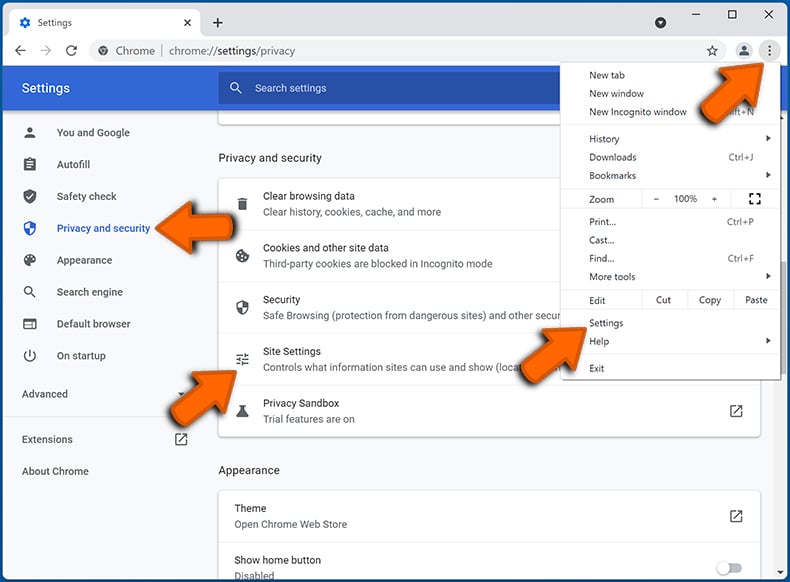
In the "Allowed to send notifications" list search for websites that you want to stop receiving notifications from. Click on the three dots icon near the website URL and click "Block" or "Remove" (if you click "Remove" and visit the malicious site once more, it will ask to enable notifications again).
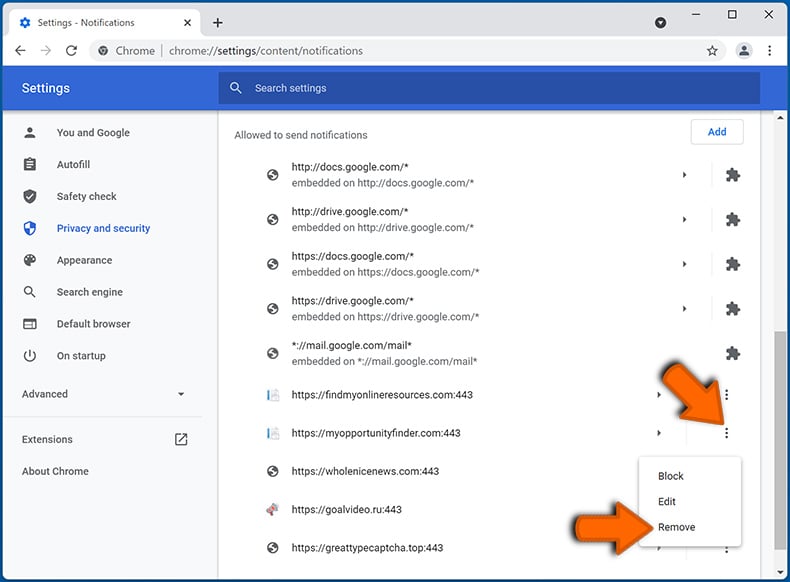
 Remove spam notifications from Google Chrome (Android):
Remove spam notifications from Google Chrome (Android):
Tap the Menu button (three dots) on the right upper corner of the screen and select "Settings". Scroll down, tap on "Site settings" and then "Notifications".
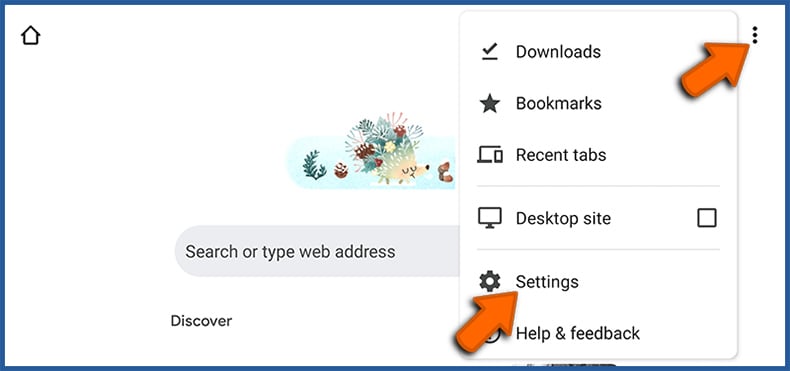
In the opened window, locate all suspicious URLs and tap on them one-by-one. Once the pop-up shows up, select either "Block" or "Remove" (if you tap "Remove" and visit the malicious site once more, it will ask to enable notifications again).
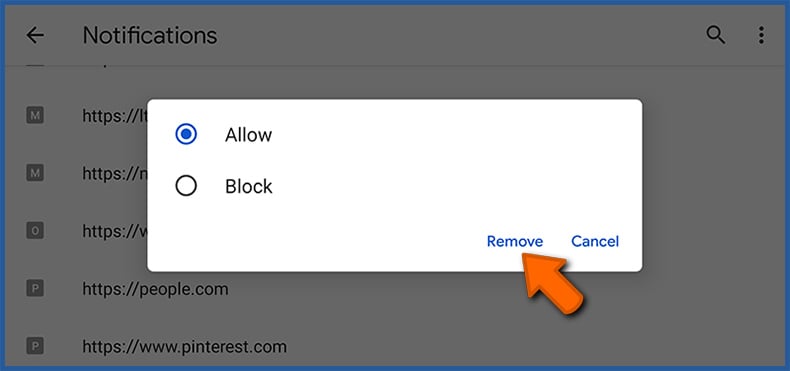
 Remove spam notifications from Mozilla Firefox:
Remove spam notifications from Mozilla Firefox:
Click the Menu button (three bars) on the right upper corner of the screen. Select "Settings" and click on "Privacy & Security" in the toolbar on the left hand side of the screen. Scroll down to the "Permissions" section and click the "Settings" button next to "Notifications".
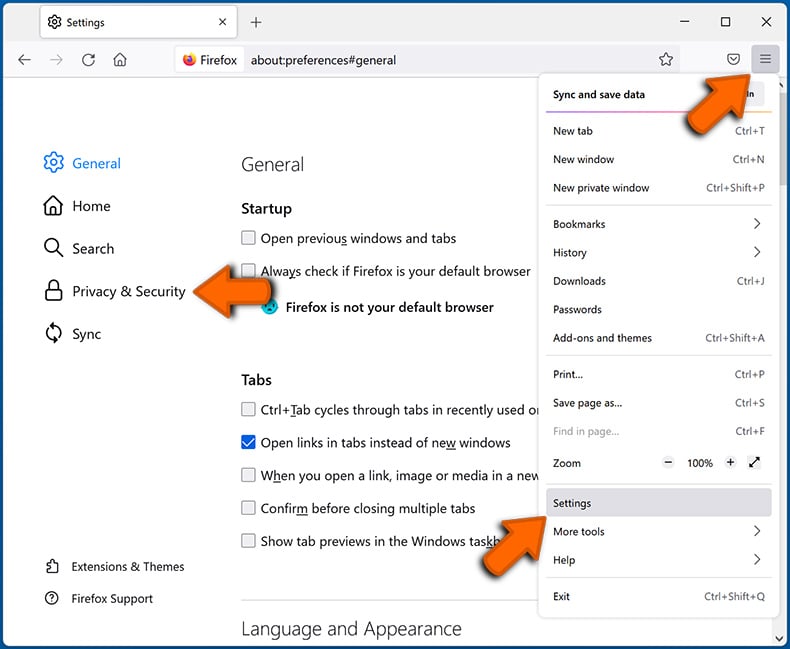
In the opened window, locate all suspicious URLs and block them using the drop-down menu or either remove them by clicking "Remove Website" at the bottom of the window (if you click "Remove Website" and visit the malicious site once more, it will ask to enable notifications again).
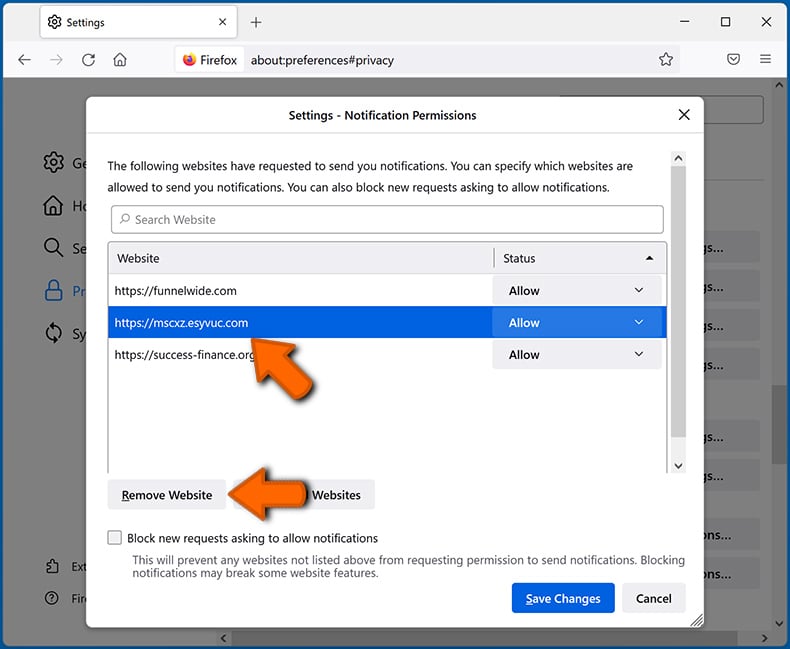
 Remove spam notifications from Microsoft Edge:
Remove spam notifications from Microsoft Edge:
Click the menu button (three dots) on the right upper corner of the Edge window and select "Settings". Click on "Cookies and site permissions" in the toolbar on the left hand side of the screen and select "Notifications".
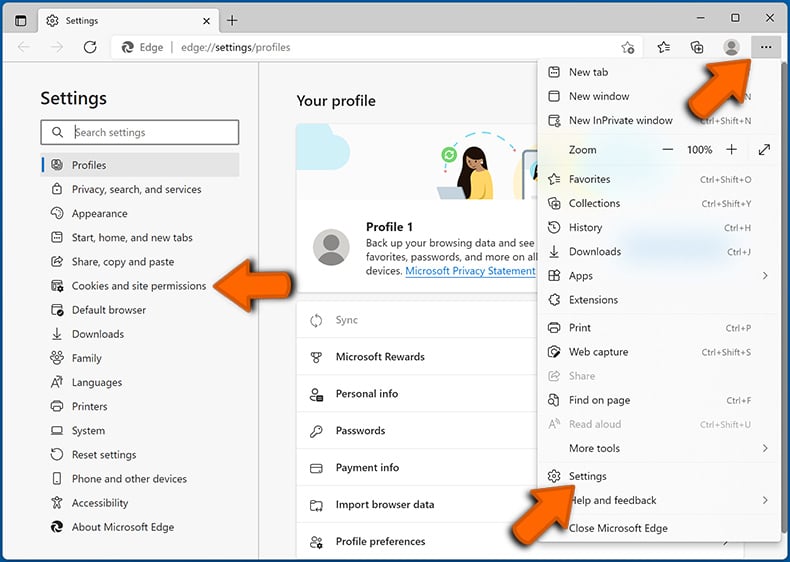
Click three dots on the right hand side of each suspicious URL under "Allow" section and click "Block" or "Remove" (if you click "Remove" and visit the malicious site once more, it will ask to enable notifications again).
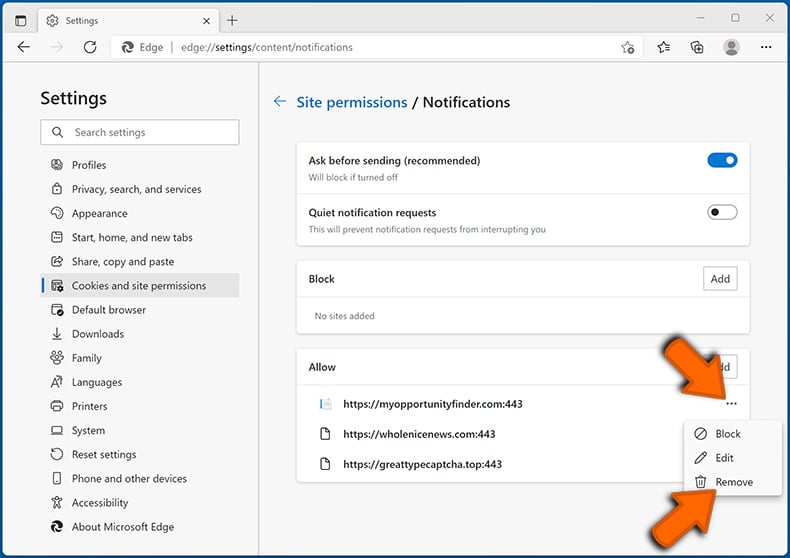
 Remove spam notifications from Safari (macOS):
Remove spam notifications from Safari (macOS):
Click "Safari" button on the left upper corner of the screen and select "Preferences...". Select the "Websites" tab and then select "Notifications" section on the left pane.
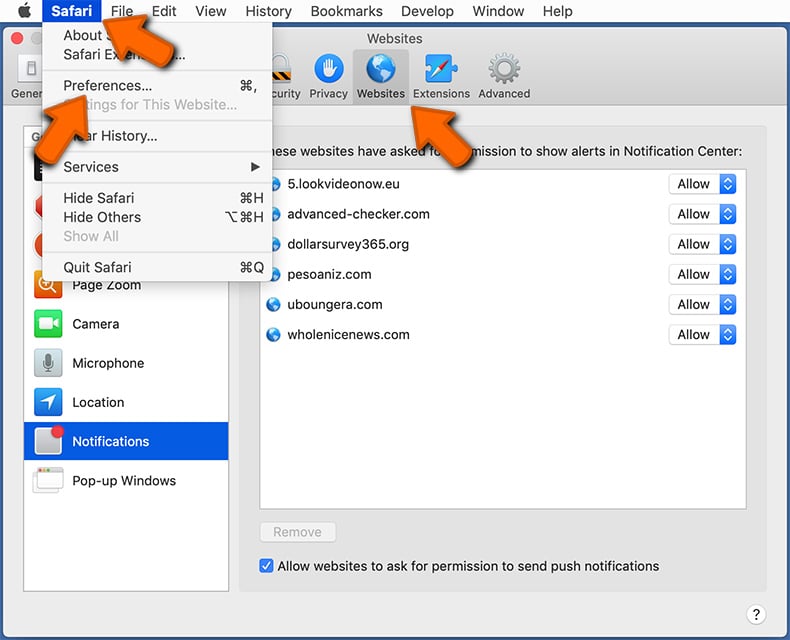
Check for suspicious URLs and apply the "Deny" option using the drop-down menu or either remove them by clicking "Remove" at the bottom of the window (if you click "Remove" and visit the malicious site once more, it will ask to enable notifications again)
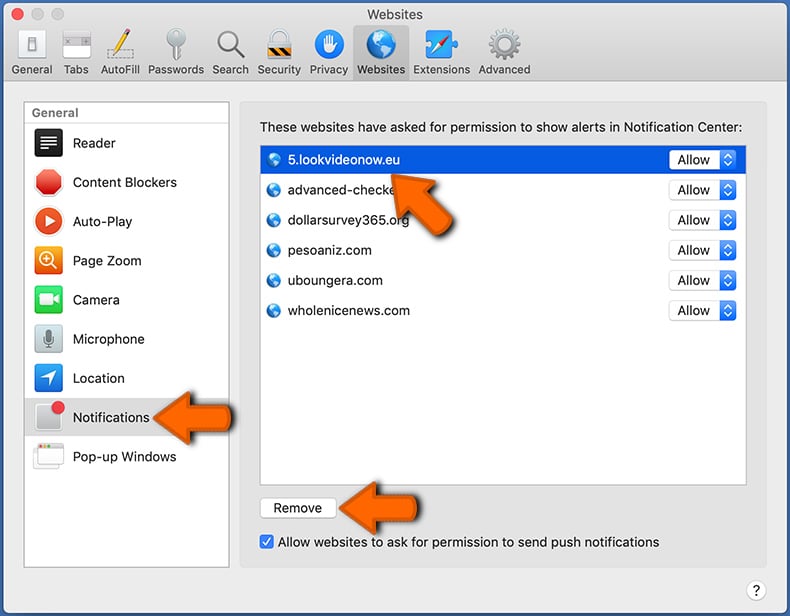
How to avoid browser notification spam?
Internet users should be very skeptical when being asked to allow notifications. While this is a useful feature that allows you to receive timely news from websites you like, deceptive marketers frequently abuse it.
Only allow notifications from websites that you fully trust. For added security - use an anti-malware application with a real-time web browsing monitor to block shady websites that tries to trick you into allowing spam notifications. We recommend using Combo Cleaner Antivirus for Windows.
Share:

Tomas Meskauskas
Expert security researcher, professional malware analyst
I am passionate about computer security and technology. I have an experience of over 10 years working in various companies related to computer technical issue solving and Internet security. I have been working as an author and editor for pcrisk.com since 2010. Follow me on Twitter and LinkedIn to stay informed about the latest online security threats.
PCrisk security portal is brought by a company RCS LT.
Joined forces of security researchers help educate computer users about the latest online security threats. More information about the company RCS LT.
Our malware removal guides are free. However, if you want to support us you can send us a donation.
DonatePCrisk security portal is brought by a company RCS LT.
Joined forces of security researchers help educate computer users about the latest online security threats. More information about the company RCS LT.
Our malware removal guides are free. However, if you want to support us you can send us a donation.
Donate
▼ Show Discussion